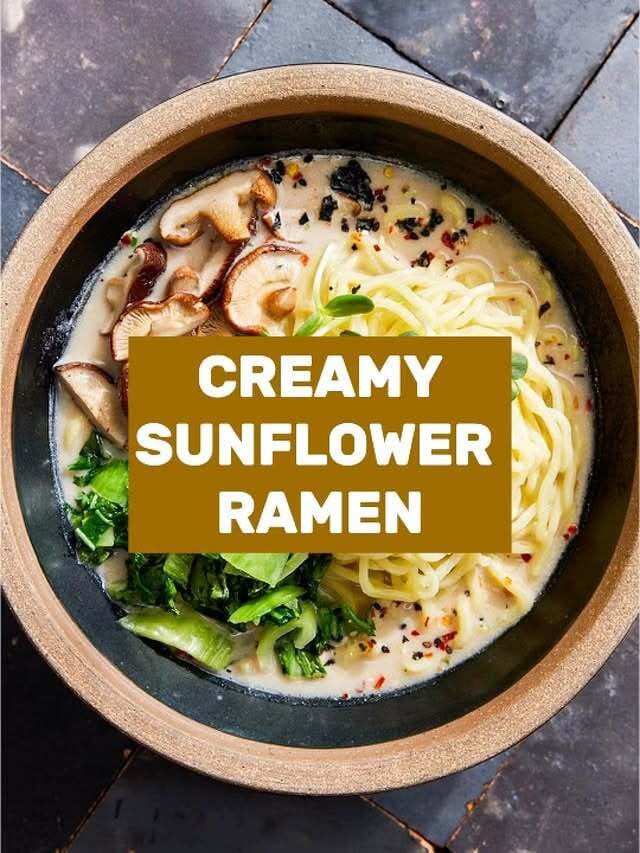- Eat at Joe's
- Posts
- Eat at Joe's: Sunflower power
Eat at Joe's: Sunflower power
How on earth can sunflower seeds replace pork? Here's how, with a recipe for Creamy Sunflower Ramen. Plus: Upgrades to this newsletter in response to the recent reader survey!
Sunflower power
Everything I knew about ramen changed in 2008, on a trip to Japan with my friend Devra. The truth is, I didn’t know all that much: maybe just that the instant stuff — as much as I appreciate it for fueling me back in my poor-college-student days — is inferior to fresh and that tonkotsu (with pork broth) isn’t the only style.
Devra knew so much more about ramen (about everything, really, and she still does), but the Ramen Museum in Yokohama was eye-opening for her, too. Upstairs, we read through an exhibit about the importance of ramen to Japan, but the main attraction is a living-history theme park downstairs set in the year 1958, when the instant version of the noodles was invented. Outposts of renowned ramen shops from all over the country serve hot, steaming bowls of broth and noodles representing various regional styles, and we ate at five of them.
Jump to the recipe
Some of the things I learned:
Ramen is artisanal, with many hours of craft behind the broths and the noodles.
It’s fast food, eaten quickly so the noodles don’t get soggy and the broth doesn’t cool too much. At Japanese ramen shops, you don’t hear people chatting with their friends, you mostly hear …
Slurping. It isn’t mandatory, but it’s certainly acceptable and even advisable as a way to cool the noodles as they go into your mouth and to keep everything moving.
Some of those regional styles include broths based on chicken; a combination of chicken and pork, beef; a ton of garlic; miso; soy sauce; and more. The noodles vary, too, from straight and thin to thick and curly.
I don’t remember tasting any vegan ramen when we visited, but that was a long time ago, and plant-based dining options have since exploded in Japan (as in so many other cities). The first time I remember tasting a vegan ramen that knocked my noodles off was in the D.C. suburbs, at chef Jonah Kim’s now-defunct restaurant Yona, named for the way his first name is pronounced in Korean. I went to watch him make it for a recurring feature in the also-now-defunct Post Sunday Magazine, and discovered that his key to a rich broth was using an imported Japanese soy milk with a thicker texture than most. (As an unashamed lover of punny wordplay, I remember also making way too many jokes about our similar names. Did I really suggest that Jonah marry me — this was way before The Husband — just so he could take my last name and refer to the place as “Jonah Yonan’s Yona”? Or that maybe it could simply be “Joe-na”? I obviously need help.)
I made it several times over the years, but when I was developing recipes for “Mastering the Art of Plant-Based Cooking,” I noticed something: When I was playing around with variations on my any-nut-or-seed “milk,” the sunflower-seed version reminded me of Jonah’s broth. Unto us a vegan ramen is born, unto us a recipe is given.
I’m including it in this newsletter because, 17 years after that first trip to Asia, I just got back from my second — this time to Korea. I plan to write more about it in future newsletters, but before I left I had been reminiscing about that Japan trip (there are so many connections between the two countries, not all of them great) and wanted to show you this ramen as a result.
As you probably know, I also recently sent out a survey of Eat at Joe’s readers (apologies for those glitches!), and today’s installment represents three additions in response to some of the requests:
A “Jump to the recipe” link high in my intro. That, of course, will help all you just-get-to-the-goods folks do just that while also continuing to serve all you I-love-Joe’s-stories people. (Thank you for the kind words, btw!)
A printer-friendly downloadable PDF of the recipe.
A list of substitutions, so if you can’t find, don’t have, or don’t want to get, say, the Japanese spice blend shichimi togarishi, you can make do with, say, a smaller amount (they’re powerful!) of crushed red pepper flakes!
Eat at Joe’s might not be as adaptable and customizable as a bowl of ramen, at least not yet, but I’m hoping these new toppings can help make it almost as satisfying. Let me know!
Fact-based news without bias awaits. Make 1440 your choice today.
Overwhelmed by biased news? Cut through the clutter and get straight facts with your daily 1440 digest. From politics to sports, join millions who start their day informed.
I break for animals:
Fig (yes, a cat!)
Recipe: Creamy Sunflower Ramen
|
4 servings // Time: Weekend // Storage: Refrigerate the noodles, broth, and vegetables separately for up to 5 days, or freeze for up to 3 months.
Broth
1 cup (140 g) raw sunflower seeds, soaked in water for 8 to 12 hours, drained and rinsed
2 cups (470 ml) water
6 cups (1.4 L) vegetable broth
1 teaspoon fine sea salt, plus more as needed
Garnishes and ramen
12 ounces (340 g) fresh shiitake mushrooms, stems composted (or saved for stock)
2 tablespoons sunflower oil
Fine sea salt
1 pound (450 g) baby bok choy, cored and thinly sliced crosswise
4 tablespoons shichimi togarashi
1 pound (450 g) fresh ramen noodles, such as Sun Noodle brand, divided into 4 equal portions
1 cup (35 g) tightly packed fresh sunflower sprouts
Preheat the oven to 400°F (200°C).
Make the broth: In a high-powered blender, combine the soaked sunflower seeds and water and blend until very smooth, 30 seconds to 1 minute. Set a nut-milk bag in a bowl, pour in the sunflower milk, close the bag, and use your clean hands to extract as much of the liquid as possible, twisting and squeezing the bag over the bowl. (Compost the pulp, or save it to add to smoothies.)
In a large saucepan, combine the sunflower milk, vegetable stock, and salt, whisking to combine. Taste and add more salt if needed. Set over medium heat, and when the mixture is very hot but not bubbling, reduce the heat to low and cover to keep hot.
Prepare the garnishes: On a large sheet pan, toss the shiitake caps with 1 tablespoon of the sunflower oil. Transfer to the oven and roast until tender, about 10 minutes. Leave the oven on. Transfer the mushroom caps to a cutting board, cut into thick slices, and season lightly with salt.
While the mushrooms are roasting, use a salad spinner to wash and thoroughly dry the baby bok choy. Transfer the bok choy to the same sheet pan you used for the mushrooms and toss with the remaining 1 tablespoon sunflower oil. Roast just until the greens wilt, about 3 minutes. Remove from the oven, season lightly with salt, and let the bok choy rest on the sheet pan.
Cook the ramen: Bring a medium pot of salted water to a boil over high heat. Ladle ½ cup (120 ml) of the hot broth into each of four deep bowls. Add 1 tablespoon of the shichimi togarashi to the bottom of each bowl. Add one portion (4 ounces/115 g) of ramen noodles to the boiling water. Cook until barely tender, 30 to 90 seconds. Use a spider sieve or slotted spoon to lift the noodles from the water, holding them over the pot to drain, then transfer them to one of the bowls. Repeat with the remaining noodles.
Divide the remaining hot broth among the bowls. (If it has separated or slightly curdled, don’t worry: Just whisk it for a few seconds, and it’ll come back together.) Top each bowl with mushrooms, roasted bok choy, and sunflower sprouts. Serve hot.
Substitutions
Sunflower seeds: Raw cashews or almonds.
Shiitake mushrooms: Cremini, button, oyster, or maitake mushrooms. (Trim, but you don’t need to remove the stems on any but the shiitakes.)
Sunflower oil: Canola, safflower, vegetable, or (untoasted) sesame oil.
Baby bok choy: Swiss chard (with stems included) or spinach leaves plus thinly sliced celery.
Shichimi togarashi: 1 tablespoon crushed red pepper flakes.
Fresh ramen noodles: Instant ramen noodles (without the seasoning packets).
Sunflower sprouts: Pea shoots, bean sprouts, or any other sprout, preferably large, that you like.
Recipe from “Mastering the Art of Plant-Based Cooking” (Ten Speed Press, 2024), copyright Joe Yonan.
More favorite noodle-soup recipes
These are gift links to the recipes at the Post. Note that they require you to register but not subscribe. Gift links are free to access for 2 weeks, so if you want to come back to any of these recipes but don’t subscribe or want to subscribe, I suggest you find a way to save them!
That’s it for this week’s newsletter. Do you have friends you think might want to Eat at Joe’s? Invite them today and don’t forget those gifts you can earn through referrals — see above!
If you were forwarded this email, welcome! And know that you can get your very own copy in your very own in-box of your very own phone or laptop on your very own Sundays by clicking below.
Until next week,









Reply